How to make Beet Kvass! An Eastern European probiotic drink made with fresh beets, sea salt and water. Full of healthy probiotics from Lacto-fermentation, these good bacteria heal the gut and support immunity.
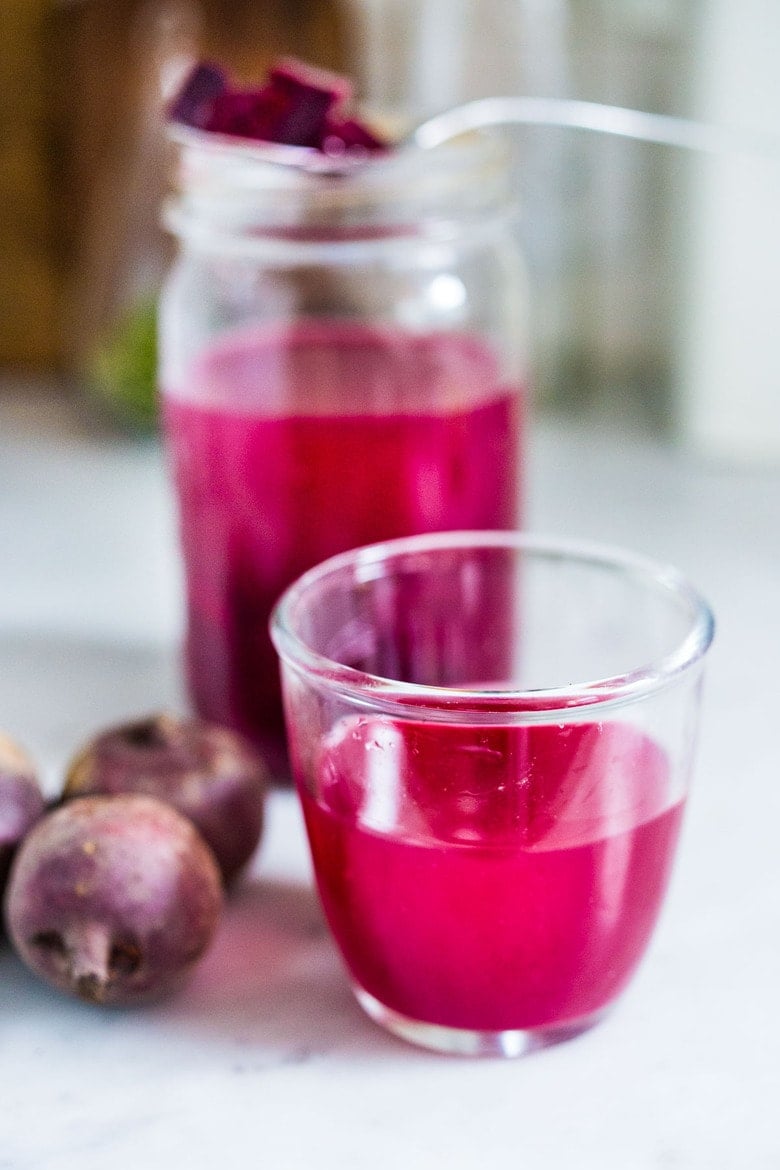
Here is a fun little recipe I’ve been playing around with for years now- Beet Kvass! Beet kvass is a fermented probiotic drink that hails from Eastern Europe that is tangy, earthy, salty and slightly sweet from the beets. Full of gut-healthy probiotics, it’s a simple way to add diversity to our microbiome and, in turn, support our immune system.
It differs from Kombucha or Water Kefir in that this fermented drink is savory and briny, made with salt, rather than sugar, more like our gut shot or pickle brine.
Why you’ll love Beet Kvass
- Easy to make– takes 15 minutes of hands-on time before letting mother nature take its course!
- Made with simple ingredients– just beets, salt and water!
- Gut Supporting! Filled with billions of healthy probiotics in just one tablespoon!
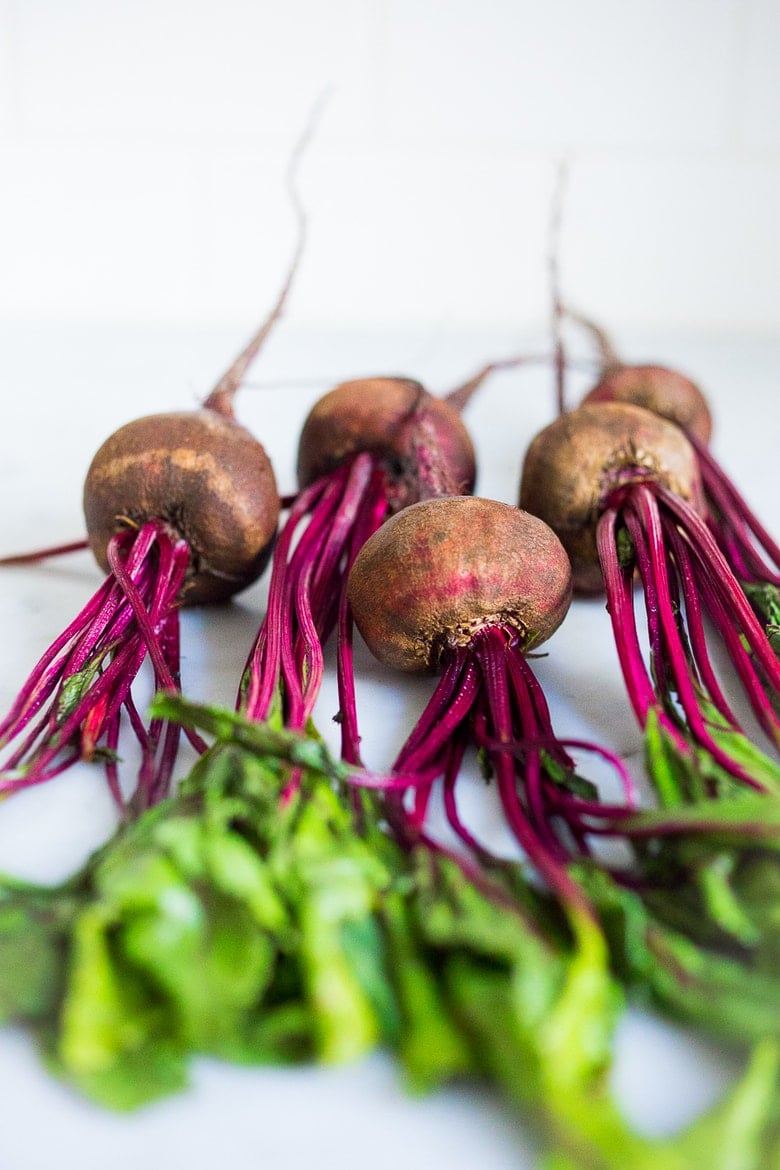 Kvass Ingredients
Kvass Ingredients
- organic beets- I love the color of red beets, but yellow beets works fine too! Use organic, unpeeled beets.
- fine sea salt- you want to use natural, unprocessed salt when fermenting.
- filtered water- chlorine in tap water can suppress fermentation, so use filtered if possible.
EXPERT TIP: To shorten the fermentation process, you can also add 1- 2 tablespoons of whey (the liquid from straining yogurt) or liquid from fermented kraut or pickle brine (the kind from alive cultures- in the refrigerated section of the grocery store, or homemade.)
Optional Beet Kvass Flavorings
- fresh dill (or fennel fronds), bay leaves, or other herbs.
- pickling spices (fennel seed, dill seed, peppercorns, celery seeds, caraway, etc) to prevent from floating, add them to the jar first.
- sliced onion and/or garlic.
- fresh sliced ginger or turmeric root.
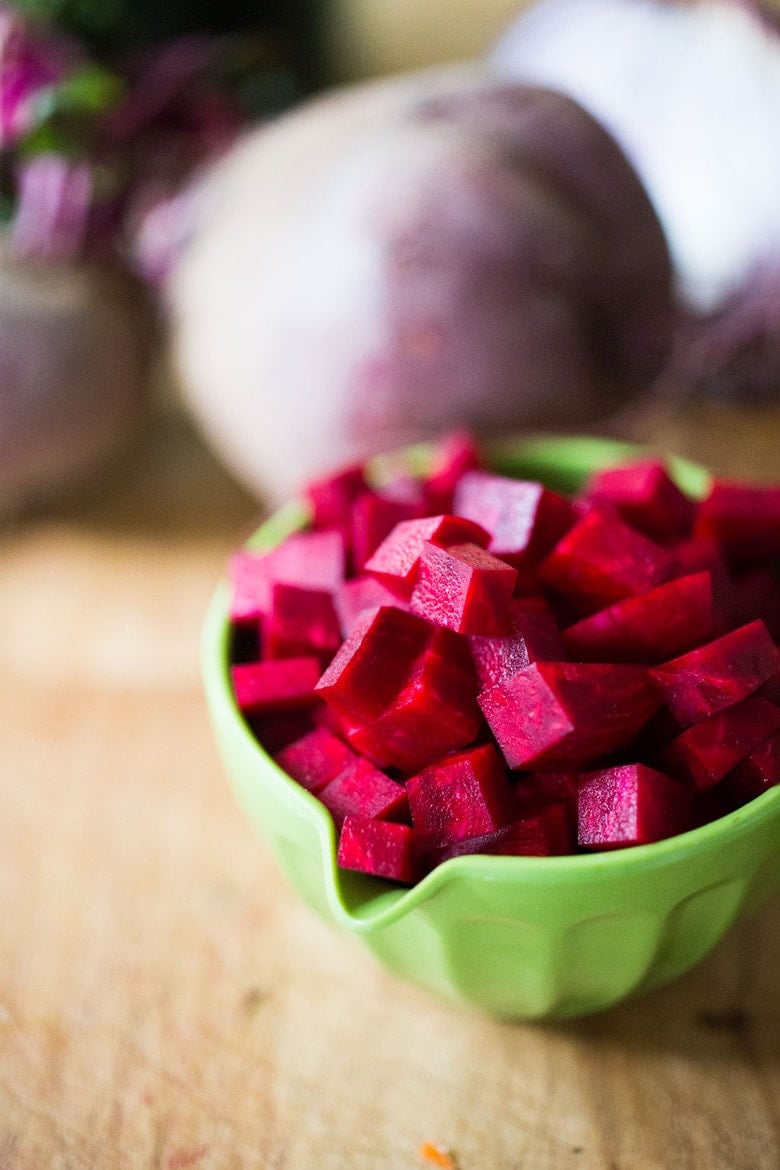
How to make Beet Kvass (instructions)
- Prep: Rinse and slice the beets into ¼-inch thick rounds, then dice them, leaving the skin on. You want that bacteria from the skin, so don’t peel! Get a clean, 1-quart mason jar.
- Assemble: If adding any whole spices, add these to the jar first, then add garlic, onion or dill if using. Add all the beets overtop. If adding whey, kraut brine or pickle brine, add this now.
- Make the brine: Mix 3 cups water with 1 heaping tablespoon sea salt. Pour this into the jar, leaving an inch of headroom at the top. If you need more brine: the ratio is 1 heaping teaspoon of salt, per 1 cup of water. Mix it first, then add. The salt will kill the harmful bacteria, but allow the healthy lactobacilli to flourish.
- Remove any spices or seeds that float to the top. Anything that touches the surface can mold. I check daily for floaters! Cover with a loose-fitting lid. Place in a bowl or baking dish (to collect any overflow- a sign of fermentation!).
- Ferment: Place the jar in a cool, dark place 60F-65 F is ideal. Check every couple days, removing seeds if need be. If you added whey or brine, you should see some action within 5-7 days. If not, it can take up to 2 weeks before you notice some slight bubbling when you tap the jar, indicating that it is fermenting. The longer it ferments, the more tangy it will taste, so you can ferment “to taste.” For an even tangier flavor, continue fermenting for 1-2 more weeks. Once happy with the flavor, refrigerate.
- Refrigerate (either strain, or leave beets in- I leave mine in). It will continue to ferment in the fridge, but at a much slower rate, developing more depth of flavor. The sugar from the beets will continue to feed the healthy bacteria.
Storage
Store beet kvass in the fridge indefinitely! It will continue to ferment and develop more flavor at a much slower rate.
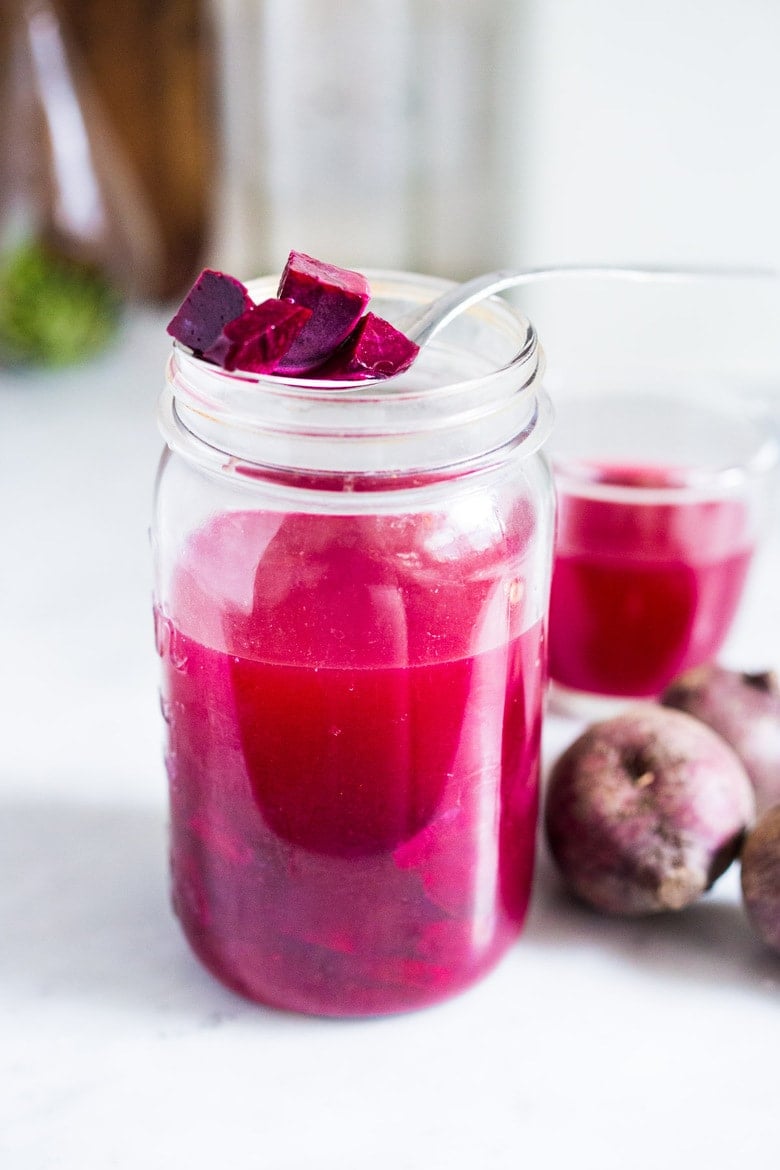
How to drink Beet Kvass
If new to fermented foods, start slowly. Drink a tablespoon first and see how you feel. You are adding millions of probiotics to your gut in just a tablespoon. This creates diversity in the gut, which is thought to be healthy! You could take a sip with every meal if you like, or take a shot once a day. I like to drink a shot in the afternoons for a refreshing pick-me-up. If it tastes too strong for you, you can water down the portion you are drinking. Yes, you can eat the beets!
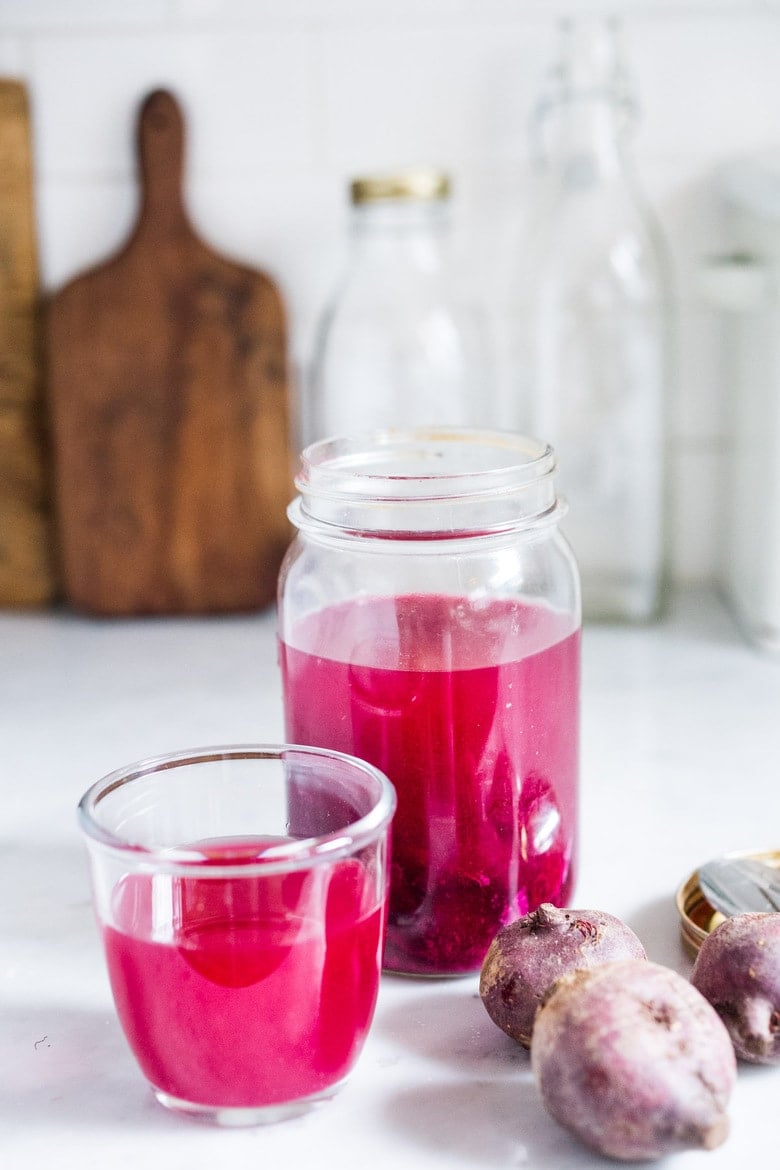
Troubleshooting
- If you notice any white foam on top of your kvass, or a cloudiness to the brine it is most likely kahm yeast and harmless. Skim it off with a spoon.
- If you see any mold, I would discard the batch.
- Beet Kvass should smell tangy and good like pickle brine – if it smells “off”, don’t drink it. A bad bacteria may have inadvertently been introduced – perhaps an unclean jar or utensils or dirty hands. It is easy to do.
- If your kvass is not tangy, it has not been fermented or not fermented long enough. This could be due to not using the right salt ratio or chlorine in your water.
More Fermented recipes you may like:
- How to Make Kombucha
- Probiotic Gut Shot
- 20+ Easy Delicious Beet Recipes
- Beet and Cabbage Sauerkraut
- How to make WATER KEFIR | an easy Guide!
- 25 Immune System-Boosting Recipes!
- How to Make Kimchi! A Quick Easy Authentic Kimchi Recipe
- How to make Sauerkraut (Simple Cultured Cabbage)
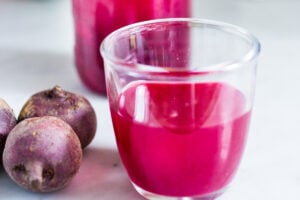
Beet Kvass Recipe
- Prep Time: 15
- Total Time: 15 minutes
- Yield: 1 quart
- Category: fermented
- Method: fermented
- Cuisine: Ukrainian
Description
How to Make Beet Kvass! An Eastern European probiotic drink made with beets, sea salt and water. Full of healthy probiotics from the Lacto-fermentation, Beet Kvass is believed to help boost immunity. It tastes slightly sweet, tangy, earthy and salty- but in a good way! With just 10 minutes of hands-on time,it is so simple- just let mother nature take its course. (Allow 2 weeks for fermentation- see notes for speeding up this process.)
Ingredients
- 2 medium beets, organic (see notes for doubling, recommended) 2 cups diced, skin ON.
- 3 cups filtered water (tap water may have too much chlorine & inhibit fermentation)
- 1 heaping tablespoon fine sea salt
Optional Additions:
- 1/4 cup fermented pickle brine or fermented kraut brine, or 1-2 tablespoons whey (liquid from strained yogurt)
- fresh dill (or fennel fronds), bay leaves, or other herbs.
- pickling spices ( fennel seed, coriander seed, dill seed, peppercorns, celery seeds, caraway, etc.) Tip: to prevent them from floating, either add them to the jar first, place beets over the top, or place a small mesh bag. Remove any that float to the surface.
- sliced onion or shallots
- fresh garlic cloves
- fresh sliced ginger or turmeric root.
Instructions
- Prep: Rinse and slice the beets into ¼-inch thick rounds, then dice them, leaving the skin on. You want that bacteria from the skin, so don’t peel! Get a clean, 1-quart mason jar.
- Assemble: If adding any whole spices, add these to the jar first, then add garlic, onion or dill if using. Add all the beets overtop. If adding whey, kraut brine or pickle brine, add this now.
- Make the brine: Mix 3 cups water with 1 heaping tablespoon sea salt. Pour this into the jar, leaving an inch of headroom at the top. If you need more brine: the ratio is 1 heaping teaspoon of salt, per 1 cup of water. Mix it first, then add. The salt will kill the harmful bacteria, but allow the healthy lactobacilli to flourish.
- Remove any spices or seeds that float to the top. Anything that touches the surface can mold. I check daily for floaters! Cover with a loose-fitting lid. Place in a bowl or baking dish (to collect any overflow- a sign of fermentation!).
- Ferment: Place the jar in a cool, dark place 60F-65 F is ideal. Check every couple days, removing seeds if need be. If you added whey or brine, you should see some action within 5-7 days. If not, it can take up to 2 weeks before you notice some slight bubbling when you tap the jar, indicating that it is fermenting. The longer it ferments, the more tangy it will taste, so you can ferment “to taste.” For an even tangier flavor, continue fermenting for 1-2 more weeks. Once happy with the flavor, refrigerate.
- Refrigerate (either strain, or leave beets in- I leave mine in). It will continue to ferment in the fridge, but at a much slower rate, developing more depth of flavor. The sugar from the beets will continue to feed the healthy bacteria.
- If you notice any white foam on top of your kvass it is most likely kahm yeast and harmless. Skim it off with a spoon and toss. If you see mold, I would discard the batch.
- Store this in the fridge, strain into a cup, and drink a few ounces daily. Yes, you can eat the beets!
Notes
This will last indefinitely in the fridge. I highly recommend making a double batch of this because of the longer fermentation time.
Flavor this up!!! I love adding onion, garlic and pickling whole spices. You can get small mesh cotton bags to put your spices in if you like, then no worries about “floaters.”
You can speed up fermentation significantly by adding a few tablespoons of whey ( liquid from strained yogurt) ¼ cup of fermented pickle brine or fermented kraut brine (make sure it is alive and bubbly- from the refrigerated section of the grocery store, not pickled with vinegar) to the jar.
Fermentation slows down in cooler places and speeds up in warmer places.
Nutrition
- Serving Size: ½ cup
- Calories: 20
- Sugar: 3.1 g
- Sodium: 1202.8 mg
- Fat: 0.1 g
- Saturated Fat: 0 g
- Carbohydrates: 4.3 g
- Fiber: 1.3 g
- Protein: 0.7 g
- Cholesterol: 0 mg




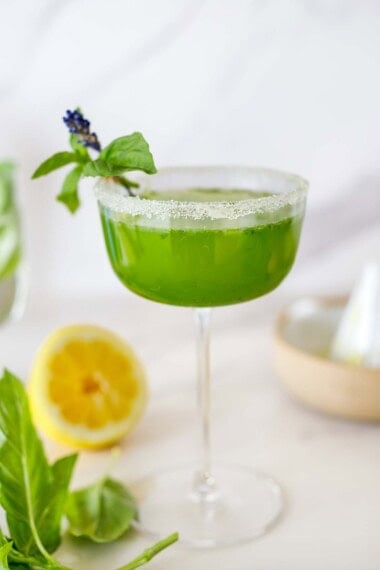
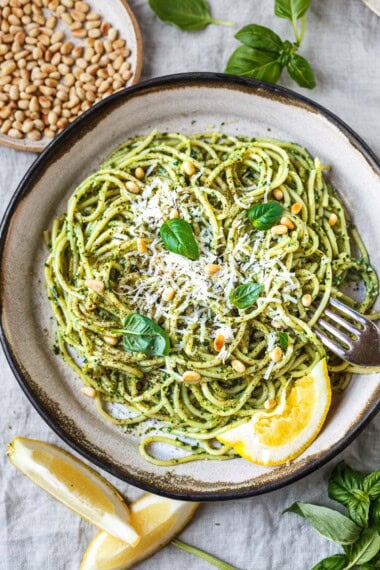
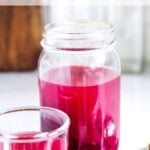
thanks for a great recipe
Glad you enjoyed Bee!
First time trying this! I’ve been fermenting it for the past 2 weeks but there are no bubbles when I tap the jar. It also tastes very tangy. Is this normal?
Hi Katrina! So the tangy flavor is a great indication that it IS fermenting. Normal and sounds perfect. You can refrigerate it at any time. 🙂
Just wanted to come back here and say this recipe is SO easy and delicious! Now I’m used to the tangy fermented flavor it’s something I’m constantly reaching for and even give it to my little one in his meals.
Love this Katrina, so important to introduce it to kids!
How do you make juice from it though. Do I put it in a juicer or blender?
The beets are fermenting in water- basically the water turns into the “juice”.
Do I add cold, warm or hot water/salt mix to the jar? Does it matter?
Room temperature water is fine. The salt will dissolve as it ferments.
This got moldy for me, bummer! The problem with adding things like coriander seeds is that they float to the surface and grow mold. How do you prevent them from floating to the top?
Hi Sara- I am so sorry about that. I added more notes to prevent this. I would add the seeds to the jar first, and layer over top. If any float to the surface, remove daily. You can also purchase little cotton mesh bags, handy if you are making this a lot!
How can i prevent the mold? I tried to make it 3 times, and every time it got mold on top. Some questions:
– do you need to solve all the salt in the water? Or just place it in the jar at the bottom?
– Do you need to place the jar in a dark place?
– Does it also work in a fermentation jar where you prevent any air to get into the jar?
Hi Sybren, sorry to hear this, and it sounds frustring! Are you spices rising to the top, or what is actually touching the surface that is getting moldy? Yes dissolve all the salt- 1 heaping tablespoon in 3 cups water. A dark place is great. Yes it will work in a fermentation jar. Are you able to add brine from another ferment, or whey?
Hey thanks for your reply. I was a bit busy so I haven’t tried to make te kvass again.
When I make it I do not use any spices yet, I just want to make a plain kvass.
It looks like a slimy foamfloating on the surface. I scoop it out with a spoon that I first placed in a glass of cooking hot water. Could I just leave the foam in? Or can I take it out in another manner?
I haven’t triedit with a brine or whey. Can I than just use a little bit of brine from sauerkraut? Or from a bottle of saurkraut juuice?
Hi Sybren, it sounds like it may be the foamy bubbles from fermenting? Yes, You can use sauerkraut brine as long as it is “fermented” (found in the refrigerator section), and not pickled with vinegar. Make sure your jar and utensils are clean. 🙂
Hey, I made it with 2 or 3 table spoons of saurkraut brine and it looks totally different!! The foam on top now looks dry and, after 5 days no mold!! it smells a bit sour, but good. Unfortunately i cannot post a picture, but i think it’s going the right way!! I’ll let you know.
Great to hear! Adding the brine is helpful!
Wrap your spices in cheesecloth, or a small piece of cotton fabric (cut from an old discarded tee shirt?). Just make sure it’s really clean. Even boil it for a few minutes. You don’t want to introduce any unwanted bacteria. It will turn a pretty pink color!
It’s not mold, it’s the fermenting foam from the beets that due to the dark color looks like mold. It’s not. Salt kills the harmful bacteria that forms mold.
Seeds and whole spices can be contained in a small pouch of cheesecloth. Keeping an airlock lid on and not opening until it’s ready to drink will help avoid mold. Mold and kahm yeast need oxygen to grow.
This turned out good!
Cool. Just tested my batch after 2 weeks. Tastes great… In a strange, lacto-fermented way. 😆 Very pretty too.
Any recommendations on what to do with the beets?
Add to salads and soups!
Will try this recipe this week!
Looks good!
Great!
A little tip about the beets after they’re no longer needed in the kavass…Gaps diet recommends using fermented vegetables in soups as they contain additional nutrients and any anti nutrients are broken down making them easily digested. I have done this with my homemade sauerkraut. It’s delicious and very healing for damaged guts. ☺️
Thanks so much Barbara!
You can definitely add the fermented beets to any dish but heating them can kill the beneficial bacteria, or probiotics in the food. As long as the temperature of what you’re adding them to is no higher than 108 degrees, you’re good to go!
Mine had some mold on top as well. If it’s because of anything besides the brine touching the air, would you suggest placing something to hold everything below the surface? Otherwise, no matter how much brine I put in the jar, the beets will float to the top. Thank you!
Yes Taylor you can use a fermentation weight if needed, or place a cabbage leaf overtop the beets and push it down under the brine. IThis is so strange… I make this all the time and the beets always sink to the bottom. But yours float?
Taylor, my beets always float to the top as well. I always use a cabbage leaf and a fermentation weight on top, just to make sure nothing can sneak up to the surface. It’s so disappointing when you ferment something for a week+ and have to throw it out because of mold. I hate that. ☹️
Hi! So I tried making this and we are about a week in. There is mold on top. In the instructions you said to keep the lid loose fitting so I didn’t tighten it. Could that be why?
Shoot Sara- Mold happens when something other than the salt water touches the air. Were any of the beets or spices floating at the top? The lid should be loose.
At what step do you add the add flavors to the beet kvass? I would like to add ginger but not sure how much or when to add to the recipe. Thank you!
Hi Anita- you could add slices of ginger right at the beginning!